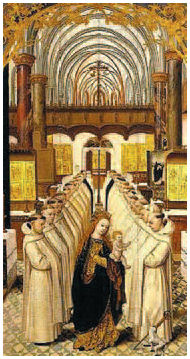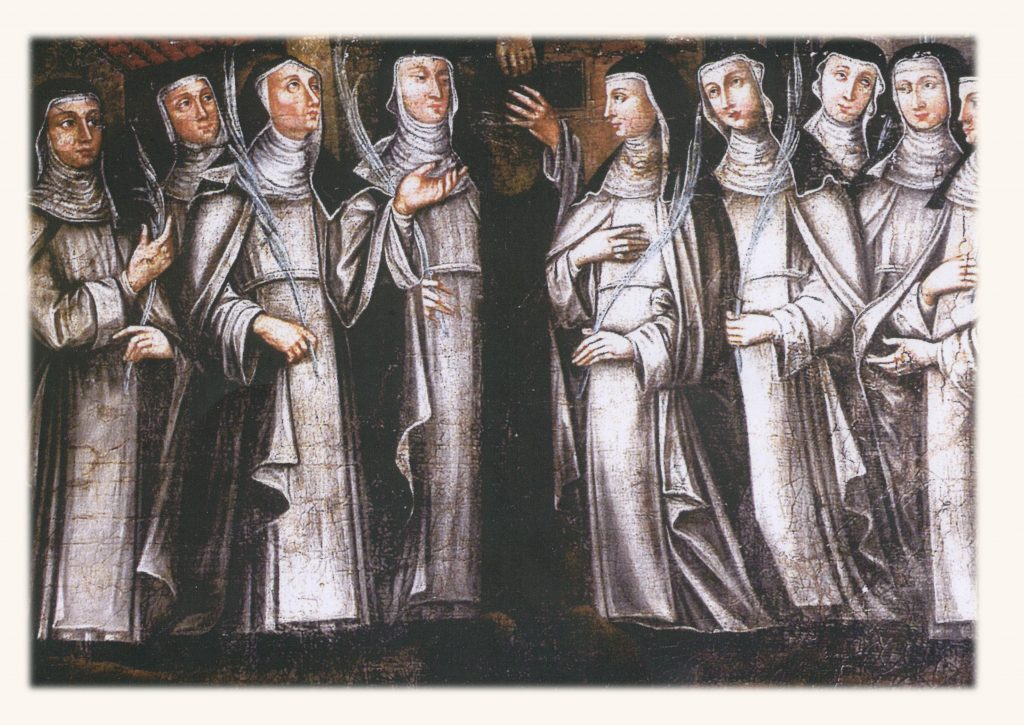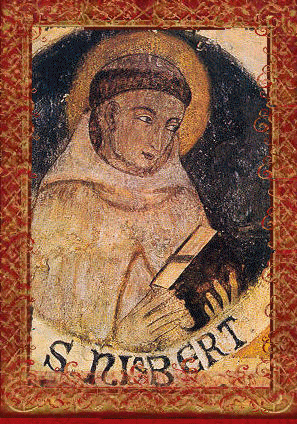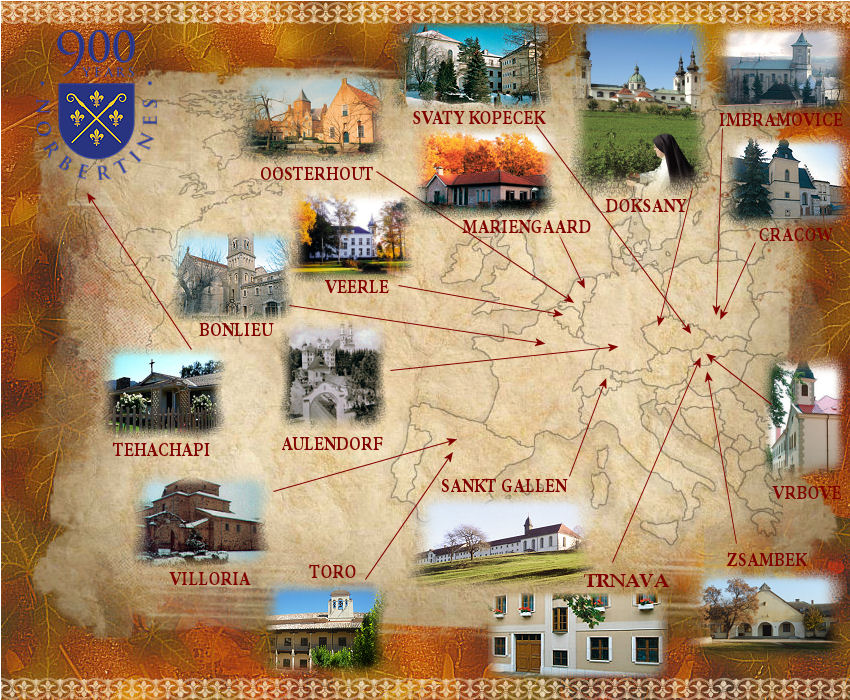
 THE HISTORY OF THE NORBERTINE SISTERS
THE HISTORY OF THE NORBERTINE SISTERS
Shortly after Norbert had settled down with his 40 confreres in Praemontre, he went on to establish the Order of the Praemonstratensian Sisters, with the help of Ricvera Clastres. According to Norbert, the Praemontre community was intended "to imitate the Jerusalem community: a multitude of believers gathered around the apostles". (1) Thus besides the canons, we find men and women resolved to 'convert', which in the 12th century meant to embrace religious life. For this reason Praemontre continued to grow after 1121 in the form of a double Abbey, with the community of the Canons, its lay brothers and its community of Sisters. Norbert liked this structure, since it represented “a multitude of believers around the apostles in Jerusalem”.
 The number of Sisters and lay brothers was in those days around 80. In an Order full of outstanding men, and women, like Ricvera of Clastres, or Adele of Montmorency, not to mention Agnes, who was a countess of Braine and who founded several monasteries, the Community didn’t lack representation from the nobility. These men and women, disciples of Norbert, were so devoted to the Eucharist and the priesthood that, following the apostolic movement, they entrusted themselves to the priests in their quest for enlightenment, just as the first Christians had entrusted themselves to the apostles. "It mattered little to Norbert and to these women, that they were not the head or arms of the Church; it was enough that by their love, contemplation and devotions, they were its heart." (1) The nuns, 'piae mulieres', lived separately, yet near to the monasteries of the Canons Regular.
The number of Sisters and lay brothers was in those days around 80. In an Order full of outstanding men, and women, like Ricvera of Clastres, or Adele of Montmorency, not to mention Agnes, who was a countess of Braine and who founded several monasteries, the Community didn’t lack representation from the nobility. These men and women, disciples of Norbert, were so devoted to the Eucharist and the priesthood that, following the apostolic movement, they entrusted themselves to the priests in their quest for enlightenment, just as the first Christians had entrusted themselves to the apostles. "It mattered little to Norbert and to these women, that they were not the head or arms of the Church; it was enough that by their love, contemplation and devotions, they were its heart." (1) The nuns, 'piae mulieres', lived separately, yet near to the monasteries of the Canons Regular.
 Besides prayer their most important job was taking care of the poor the pilgrims and the brethren. The leader of the nuns was the Prioress. The magister exteriorum ruled the details of the Sisters` community life. After the death of Norbert, by 1137, influenced by a rigorous trend that tended to separate the Nuns from the Norbertine fathers, the Fathers started to dissolve the double cloisters.
Besides prayer their most important job was taking care of the poor the pilgrims and the brethren. The leader of the nuns was the Prioress. The magister exteriorum ruled the details of the Sisters` community life. After the death of Norbert, by 1137, influenced by a rigorous trend that tended to separate the Nuns from the Norbertine fathers, the Fathers started to dissolve the double cloisters.
"Hugh Fosses, the Abbot of Premontre thought that the General Chapter should adopt the principle that the double cloisters should be divided, which is what Norbert had already tried to do in Cappenberg and Ilbenstadt. From this point on the Norbertine nuns found themselves in a new situation. Specifically, they became responsible for chanting the Divine Office by themselves. The needs of a religious community of women led them to adopt an internal structure similar to that of the men`s communities. The educated Sisters became sorores cantantes, while those who were illiterate became sorores conversea". (1) Around 1240 the annual Chapter of the Abbots discussed again the problem of the Sisters and created a new Constitution for them. In the light of this, the Monastery could receive no more than 20 Sisters and their Prioress had to be under the instruction of the Abbot. Further monitoring was to be conducted by the Circator appointed by the General Chapter. He was the one who received the young girls into the Order, and they in turn put their vow into his hands. The Praemonstratensian Sisters followed the contemplative life in their Monasteries in the 13th century, but they performed charity services as well: taking care of the poor, caring for) the sick and welcoming guests. There was a House (Somlovasarhely in Hungary) which continued to carry out authentication activities up to the time of the Turkish invasion. The habit worn by the Sisters was similar to that of the Canons Regular, and they also received the title of the Canonesses.

The decision of the General Chapter to separate the women`s Communities from those of the men`s Abbeys had different results in different regions. "In countries where the Chapters decrees were rigorously enforced, the Sisters were settled on farms or rural lands" (1) There were many examples of this. The Sisters were housed in a separate building at a distance from, but in the same geographical area as, the Norbertine priests. They remained independent of the Fathers. In some places the Sister's Community occupied the Monastery and the priests moved to another Abbey. Some Communities who had to leave their cloister joined the Cistercian Nuns.
The Circaries in Brabant, Flanders and Saxony took very seriously the double-cloister decision and migrated to Middle and Eastern Europe. So although Norbertine nuns disappeared from France, Belgium, Burgundy and Switzerland, the number of convents was rising in Westphalia, Bohemia, Moravia, Poland and Hungary. This was partly because the nobility and wealthy people wanted a good education for their daughters.(2)
Writing of this period Bernard Ardura says: "In France the only place that remained, was St. Margaret of La Rochelle, until the city was invaded by the Calvinists. In Spain, St. Sophia in Toro and Villoria in Orbigo, broke with the Order and rejoined it later, which is what saved them. In Hungary, the women's Monasteries prospered, until they were totally destroyed by the Turks in 1590. In Poland, all the women's Communities lasted until the first partition of Poland in 1772. Westphalia, and to a certain extent Bohemia, were really the land of the Norbertine Canonesses, recruited for the most part from among the nobility. Nowhere else were they so numerous: There were thirty-three monasteries for women versus 15 abbeys. In Germany double monasteries were maintained until 1803 in Oberzell, Spieskappel, Ilbenstadt and Adelberg. These women`s communities were self sufficient to that of the Canons. Two Norbertine nuns have received the honours of the altar. Blessed Gertude of Hessen (Germany), who was offered as a very young girl to the Monastery of Altenberg by her mother St. Elisabeth of Hungary and blessed Bronislawa of the Monastery of Krakow, a first cousin of St. Hyacinth. The process for the beatification of Emilia Podoska (Zwierzyniec) and of Sr. Rose of (Bonlieau) has already started.
THE PRAEMONSTRATENSIAN SISTERS TODAY
The Apostolic way of life of the Sisters
"St. Norbert gathered together clerics and very many lay people (see Vita Norberti B XXIV, 50). "He kept those whom he gathered in the bond of unity through the Word of God and the grace of the Holy Spirit... He taught them to be lovers of voluntary poverty and imitators of Christ's obedience in all things" (Vita Norberti B XVIII, 37).
Filled with zeal for the Kingdom of God and living in expectation of the world to come, St. Norbert and his first followers devoted themselves to "following the Sacred Scriptures and having Christ as their leader" (Vita Norberti XXV, 53). Thus, they patterned their lives on the Vita Apostolica, the way of life led by the Apostles and first disciples of our Lord as recorded in the Gospels and in the Book of Acts.
The Apostolic Way of Life followed by the first Christians remains for all ages the model and ideal for the Church, a community united by faith in the Word of God handed down through the Apostles (see Acts 2:42), and by the gift of the Holy Spirit given in Baptism and nourished through the Holy Eucharist. The Vita Apostolica is characterized by a union of the hearts and minds of the faithful in God, and by a communion of goods among them (see Acts 4:32); by holding the Eucharist as the centre of all life (see Acts 2:42) and persevering together in prayer with Mary, the mother of Jesus (see Acts 1:14); and by giving witness to the Resurrection of the Lord (see Acts 4:33). This ideal of apostolic life is enshrined in the Rule of St. Augustine which Norbertines follow.
Shorty after founding the canons, St. Norbert received women into his Order beginning with the noble widow, Ricvera of Clastres. This incorporation of women perfectly corresponded with the ideal and the spirit of St. Norbert and his first followers who wished to revive that way of life in which the Apostles "devoted themselves with one accord to prayer, together with some women, and Mary the mother of Jesus, and his brothers" (Acts 1:14, NAB). Like the Norbertine canons, Norbertine canonesses are consecrated for the service of divine worship, and vow to live "according to the Gospel of Christ and the Apostolic way of life" (From the Formula of Solemn Profession). However, the canonesses fulfil the wholly contemplative dimension of this Norbertine propositum and thus live a cloistered (…) life with a truly Apostolic spirit." (from the homepage of the Norbertine Sisters in Tehachapy)

A short summary of the history of the communities of the Norbertine Sisters in the world today
The Norbertine Community of Saint-Catharinadal Oosterhout (Netherlands) can reflect on a history of more than seven centuries. The recorded history begins in the year 1271. From the beginning, Saint-Catharinadal has enjoyed the protection of the Lords of Breda. It became possible in 1847 for sisters from Oosterhout to start a new community in the Belgian Neerpelt. The sisters from this group moved in 1955 to Veerle (Belguim). It became independent of Oosterhout in 1920. The Community of Canonesses Praemonstratenses of Santa Sofia Toro (Zamora-Spain) and the one of Villoria de Orbigo (Leon) form a unique pair. First it was situated in the double Monastery of the Praemonstratensian Fathers of San Miguel de Grox; in accordance with the then current custom of the Order, sharing its church. When the double cloister was dissolved, the five surviving Sisters of the double Monastery of San Miguel de Groh were transferred to the house of Santa Sofia on June 12 1304.
In 1243, Rodrigo Fernandez Valduerna (Count of Astorga) donated his palace, which was in the village of Villoria de Orbigo to the Praemonstratensians. The Norbertine Fathers lived here until 1511 when the Fathers left and seven Sisters came here from the Monastery of Santa Sofia. The Norbertine nuns have been living here ever since.
In Germany there were more than 35 houses of the Sisters in the Middle Ages, but none of them survived. But in 1947 the convent of St. Norbert in Windberg wanted to restore the historical Abbey of St. Norbert in Rot an der Rot. Therefore the Praemonstratensians founded a new community of Sisters
In the 12th century there were many Norbertine Sister communities in France, but we find only two of them in the 14th century, and they slowly died out. The Norbertine Sister community in Bonlieau was founded in 1871. There were Sister communities in Switzerland as early as 1126. In the first half of the 13th century there were 15 cloisters, but they did not survive the 14th century, the time of the Reformation. The Cloister Berg Zion in St. Gallen was founded in 1766 with the aim of Perpetual Adoration.
One of the oldest foundations of the Sisters` Monasteries is in Doksany (Bohemia, near Prague). This monastery was established in 1144 by Princess Gertruda as a Sisters` Convent of the Monastery of Strahov in Prague. The cloister developed so quickly, that they could initiate further foundations, like the Monastery in Krakow-Zwiezyniec (Poland), in 1162. The regular life in Doksany was uninterrupted until 1782 when the Convent was abolished by order of Emperor Joseph II. Some centuries later in 1998 it was re-established from Krakow-Zwierzyniec. According to one theory, the Monastery in Zwierzyniec (Poland) was founded in 1148, by Agnieszka, the sister of Princess Gertruda, who founded the Convent in Doksany. The Monastery of the Sisters in Imbramowice was founded, with the help of the Norbertine Sisters in Krakow, by Iwon Odrowaz, the bishop of Krakow, in 1226. It is situated on the side of the Dlubnia River, 40 kilometres northwest of Krakow.
The Order of the Praemonstratensian Sisters of Hungary was re-established in 1927 after a period of 300 years. This was in Külsővat and was founded by the Sisters of Zwierzyniec and by a Hungarian Norbertine Father, Dr Sebastian Ráday. The first Prioress of this young Community had earlier been a Prioress in Imbramovice, Sr. Wisniecka Anzelma. After the socialist regime, the motherhouse was placed to Zsambek.
The Congregation of the Praemonstratensian Sisters of Slovakia and Bohemia was established in 1902 on the Holy Mountain (Svaty Kopecek) near Olomouc, by the Norbertine Father, Frejka from Strahov with the help of Sr. Michaela from Zwierzyniec. Today the Congregation has two provinces, Czech and Slovak. The house of the Superior of the Congregation is in Trnava (Slovak Republic); the motherhouse of the Slovak province is also in Trnava. The motherhouse of the Bohemian Sisters is on the Holy Mountain - Olomouc (Czech).
The Norbertine Community Mariengaard (Netherlands) was actually founded on June 6th 1992, as an association of women wanting to live as religious, sharing prayer, life and possessions.
The Norbertine Association of St. Joseph Tehachapy is the first foundation of future Norbertine Canonesses in the United States. They were founded by, and were affiliated with, St. Michael's Abbey, in Orange County, California, in 1997. In 2001, the Monastery was named "Bethlehem Priory of St. Joseph". In 2011the Community was fully integrated in the Norbertine Order.
Today we have around 320 Norbertine Sisters living in 13 different communities on two continents, Europe and the USA.














 |
|  www.norbertinesisters.com
www.norbertinesisters.com